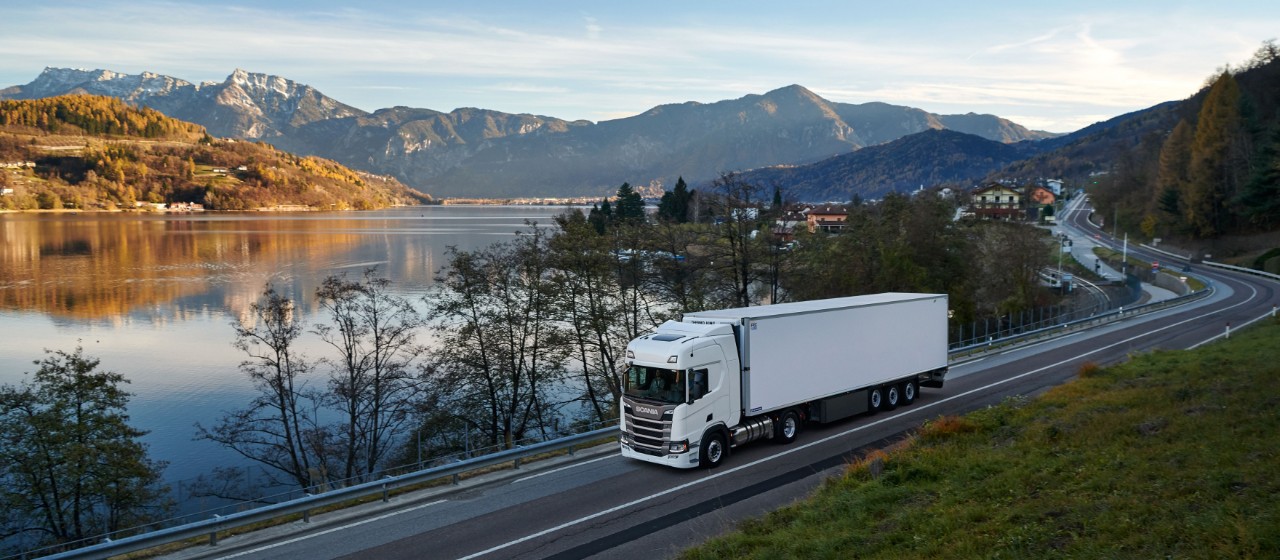
Scania welcomes new EU rules to curb heavy vehicles’ CO2 emissions
4 MAY 2018
Scania’s aim is to drive the shift towards a sustainable transport system. Our sustainable transport solutions rest on three pillars: energy efficiency, alternative fuels and electrification, and smart and safe transport.
It is by combining the three pillars that we can move towards a sustainable transport system. Energy-efficient combustion engines will continue to play a role in the transport system of the future, running on fossil-free fuels or combined with an electric powertrain.
From January, 2019, new rules will require heavy duty vehicle manufacturers in the EU to register a Vehicle Energy Consumption Calculation Tool (VECTO) value. This value is generated through the VECTO simulation tool that calculates the fuel consumption and CO2 emissions from a complete truck and trailer combination or a rigid truck with a standard box.
The new rules will initially apply to emissions from the most common trucks on European roads, 4×2 and 6×2 configurations. Other configurations, 6×4 and 8×4, will follow from 2020. After that buses and coaches most likely will follow.
In May 2018, the European Commission also expects to announce the next step in its CO2 legislation, CO2-standards, whereby limit values for CO2 emissions for new trucks will be set.
For the new EU-legislation Scania emphasises the need for an integrated approach to carbon reduction. This should encompass alternative fuels, driver training, vehicle optimisation, more efficient logistics and semi-autonomous platooning.
To deliver on the Paris climate agreement target, the world must halve its CO2 emissions each decade. All sectors of the society need to contribute and reduce emissions.
With heavy vehicles producing some 25 percent of CO2 emissions from road transport in the EU, and approximately five percent of total EU greenhouse gas emissions, these new regulations can contribute to the needed reduction.
The EU passenger car CO2 regulation has been in force since 2012. However, regulating CO2 emissions from heavy duty vehicles is far more complicated. A truck is an individually built work tool for professionals to perform specialised transport tasks. Trucks are therefore sold in thousands of different configurations.
Scania supports EU’s action
Scania views the EU regulations as an important step in the shift towards a sustainable transport system. Scania has a long track record of commitment to sustainability. CO2 emissions and fuel consumption from new Scania trucks have been cut by 25 percent since the mid-1990s.
The fuel consumption in Scania’s new truck generation on average five percent lower than the previous generation. Scania has recently won several fuel efficiency tests with the new truck generation.
These CO2 savings over time have been achieved concurrently with dramatic decreases in NOx and particulate matter emissions from heavy vehicles. With clear benefits for air quality and public health in Europe.
“We support the action that the EU has taken to regulate CO2 emissions from heavy vehicles, says Erik Dahlberg, Head of Regulation and Standards at Scania.
“This regulation will strengthen the shift to a more sustainable transport system. It will also increase transparency and strengthen market forces. A truck with low fuel consumption will also obtain a low VECTO value.”
Tackling CO2 emissions needs integrated approach
Nevertheless, Dahlberg emphasises that the new regulations are just one of several actions that are needed to further reduce CO2-emissions from heavy duty vehicles.
“VECTO does not take into consideration the integrated approach that Scania advocates,” he says.
“Alternative fuels, driver training, the right maintenance of the vehicle, improvements of trailer or body, route planning and semi-autonomous platooning are not yet included. These are solutions available here and now. We need to continue to promote the integrated approach. The VECTO simulation tool needs to be further developed.”
Scania helps customers all over the world to reduce both their fuel consumption and climate impact via this integrated approach. Profitability and sustainability go together for the customer. Additionally, as a simulation tool, Scania believes that VECTO is not always a full substitute for what customers encounter in real-life operations.
“VECTO will be based on a simulation, helping customers choose the optimal truck with regard to CO2 emissions and fuel consumption. It is a simulated value, based on a standardised transport mission and a standard body. This means that VECTO cannot represent all relevant driving situations and truck bodies. At the end of the day, what matters most for us is our customers’ real-life fuel consumption. It will ultimately be the most important factor for us at Scania,” says Dahlberg.
THE VECTO VALUE CALCULATION
- The CO2 regulation is based on certified component data and a simulation tool.
- The extensive testing and certification process will be carried out by Scania. The certified data is fed into the simulation model based on which components are included in the specification of the particular truck. A VECTO figure is generated for each assembled truck as it leaves the factory.
- The key elements that determine the CO2 values are the engine performance, the tyre rolling resistance, the aerodynamic drag, the efficiency of axles and the efficiency of transmission.
- Measured performance data from vehicle components are used in the VECTO simulation tool to calculate the fuel consumption when driving on standard roads.
- VECTO computes the fuel consumption in litres per 100 kilometres and the fuel consumption per transported tonne kilometre, as well as the CO2 emissions.
- Fuel consumption is directly related to CO2 emissions – each kilo of diesel corresponds to three kilos of carbon dioxide.